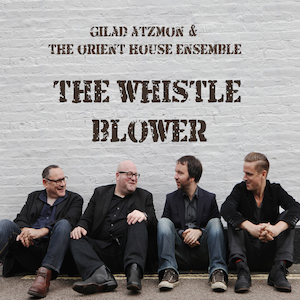The Whistle Blower is packed with different tastes, styles and moods. The opening track “Gaza Mon Amour” starts with a thumping Eastern beat and melody which transforms into a moody middle section with Gilad Atzmon’s always-dextrous sax conjuring up the feeling of a bazaar with all its mysteries and depths. The piano of Frank Harrison then introduces a classical topping, and the piece returns finally to the Eastern-inspired theme again. “Forever” is a sweet, gentle melody, the beautiful theme set by the sax before the piano takes it and develops it, then returns at the last to the original melody.
“The Romantic Church” takes you on a fantastical journey through majestic sax lines, backed by gentle percussion and bass lines with the piano once again soaring in the middle section. The piece is lifted by emotive playing from Gilad Atzmon, as he sweeps in and out on sax. “Let Us Pray” starts with a sax and drums entry, then a pause before first percussion, then the sax again repeats the theme before the piece develops — scaling up and up, soaring and taking the listener with the musicians as all follow the sax leads. “The Song” is short but very sweet with accordion, drums and piano creating a sense of a boulevard feel. The bass of Yaron Stavi soloes in the middle section and introduces a darker, softer element before the swinging, gentle swaying theme is allowed to re-emerge.
“To Be Free” starts quietly, with a heartfelt sax rendering, before the keys develop the theme and the track revolves around this. “For Moana” — a reference to Moana Pozzi, an Italian porn actress — is a quiet, free-rolling number made by the interaction of sax and piano. The Whistle Blower concludes with its track, and it’s lighthearted with some great vocals from Tali Atzmon and Antonio Feola. The song swings from a sexy introduction with wolf whistles and lazy, laid back singing from the band, an accordion, a bit of unison singing, a bit of background whistling, and a dollop of bawdiness.




